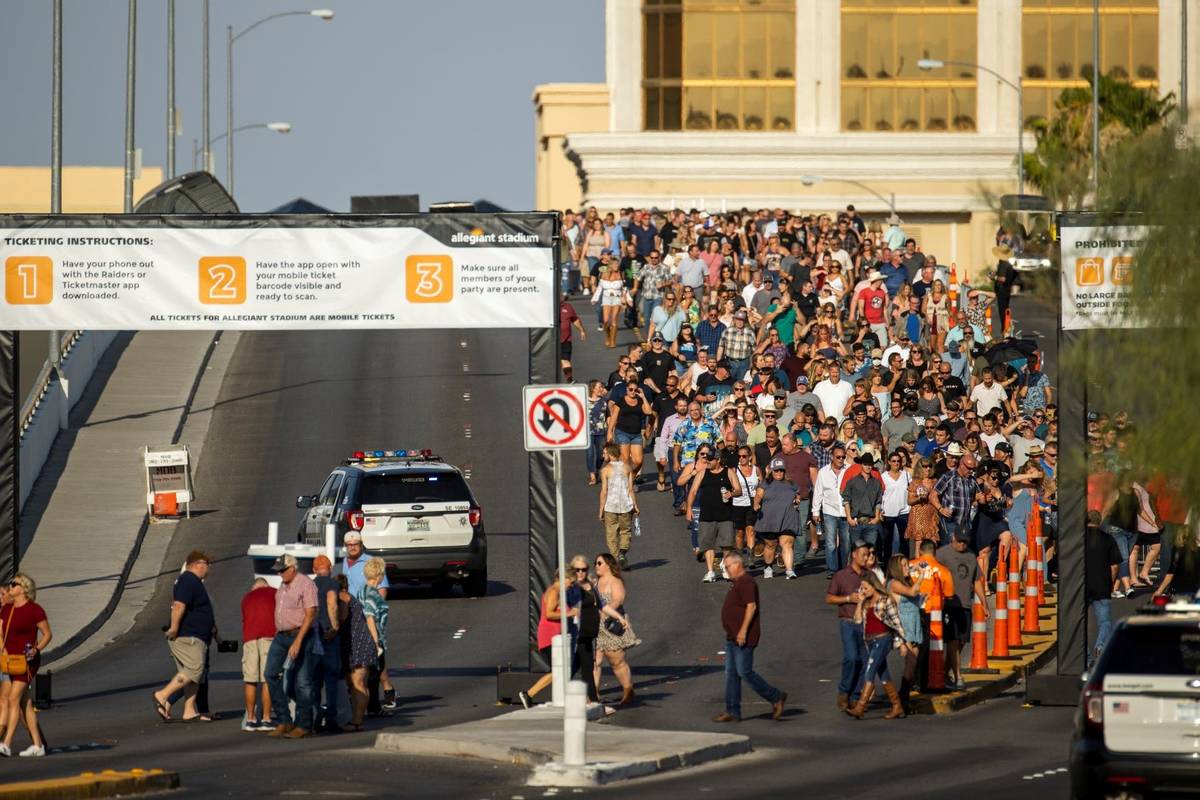Allegiant Stadium traffic sluggish at Garth Brooks concert

With Garth Brooks playing the first sold-out show at Allegiant Stadium, officials involved used the mega-event as a learning experience on event-day traffic management.
And by most accounts, there was plenty to learn.
“This is the first time over 60,000 people ever gathered in an indoor venue like this in Las Vegas, so there was never a doubt that there were going to be issues that would be learned through a live, in-person event,” said Clark County Commissioner Michael Naft, whose district includes the stadium. “I think there were lots of departments and agencies that were taking notes and making sure that every situation was an opportunity to learn from.”
About 5 p.m. Saturday, traffic backups tied to the show began with the brunt of it along Russell Road westbound from Las Vegas Boulevard, as seen on Regional Transportation Commission’s traffic cams. Heavy backups on Tropicana Avenue near Dean Martin Drive were also spotted on the cams.
Officials shut the Hacienda Bridge to vehicle traffic just before 5 p.m. so fans could make the walk to the $2 billion stadium. Fans were seen trickling toward the stadium shortly after.
“Using the Hacienda bridge for pedestrian access to Allegiant Stadium is proving to be an effective and direct route for attendees from locations east of I-15, including the Las Vegas Blvd Resort Corridor,” said Theresa Gaisser, director of RTC’s Freeway and Arterial System of Transportation.
Extreme heat
One thing event organizers hadn’t planned for on Saturday was tying the all-time high temperature of 117 degrees in Las Vegas. The thousands of spectators utilizing the bridge were subject to the intense heat as they crossed over from the Strip between 5 p.m. when doors opened and 7 p.m. when the concert began.
Additionally, law enforcement officials and stadium employees were affected while working outside in the extreme heat.
“In speaking regularly with Metro (Police), Clark County fire and Clark County Public Works on it, I think there were several elements that kind of came into play,” Naft said. “The biggest factor besides it being the first capacity event at the stadium was the heat. That played a significant factor, more so than anybody could have anticipated. There were quite a few people that were taken out of commission on the traffic enforcement and logistics side because of the heat.”
With up to a third of a sold-out crowd expected to walk across the Hacienda bridge for games and events, enhancing that route to help eventgoers cope with extreme heat is also being discussed.
“We’ll make sure that they add more tents and water stations as well, particularly on those hot summer days,” Naft said.
The recent shortage of available Uber, Lyft and taxi drivers was also a factor in fans leaving the area after the show ended, Naft said.
The issue for those seeking a ride could have also been impacted by a sold-out UFC 264 taking place at the same time at nearby T-Mobile Arena and a Bruno Mars show at Park Theater, Gaisser noted.
“Last Saturday, Las Vegas hosted multiple large events adjacent to the Resort Corridor,” Gaisser said. “With the mix of local and visitor event attendance, a variety of transportation options were utilized by event-goers, including walking, transit, rideshare, shuttle busses and personal vehicles.”
On the driver side, local Uber driver William Scottt Simon said there was a lack of signage directing motorists where to find certain areas and lots, like the ride hailing lots.
“No signs on the roadways giving information or directional procedure to drivers,” Simon said. “We always see those kinds of signs on interstates for construction. Lane closed ahead, merge right, merge left. I saw none of that Saturday night.”
What can be improved
Naft said talks have already been held between the various agencies and meetings are planned to go over what can be improved, including added signage.
“Looking at what routes worked, what didn’t work, what needs to be adjusted and what wayfinding needs to be improved on,” Naft said. “We’ll make sure we continue to learn from every opportunity.”
Gaisser also noted it’s a work in progress for the RTC as it looks for ways to improve providing transportation-related info to motorists surrounding special events.
“The RTC is continuing to work with local partners to share details of road closures and one-way access during special events, updating messaging along I-15 and I-215, and adjusting traffic signal timing in and around the events,” Gaisser said.
Naft said that despite a few hiccups Saturday night, the transportation plan went as well as could be expected with over 60,000 fans converging on one area, noting it will be smoother over time.
“There’s a huge education element here, making sure that not only do attendees know where they’re going, but the rideshare drivers, the taxicab drivers, people dropping their friends and family off for the event — making sure they all know how and where to go,” Naft said. “Just like we saw at T-Mobile Arena, eventually everybody found their favorite way, in and out, they got to learn what the road closures were and adapted accordingly.”
Contact Mick Akers at makers@reviewjournal.com or 702-387-2920. Follow @mickakers on Twitter.